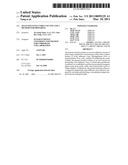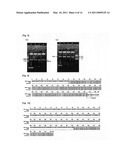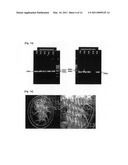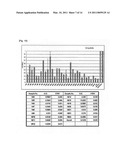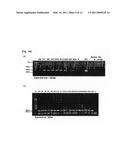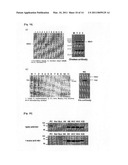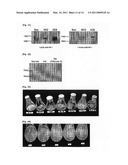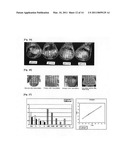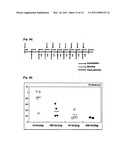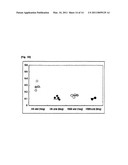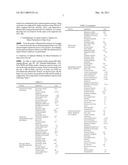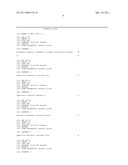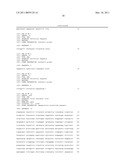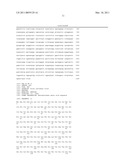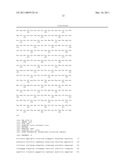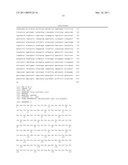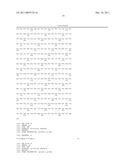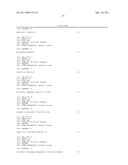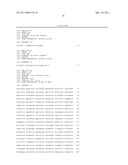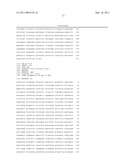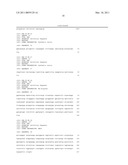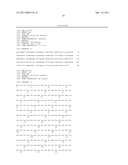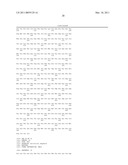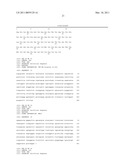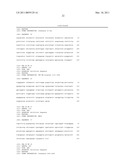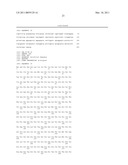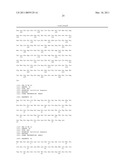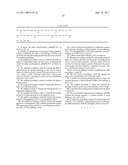Patent application title: AVIAN INFLUENZA VIRUS VACCINE AND A METHOD FOR PREPARING
Inventors:
Joo-Sung Yang (Seoul, KR)
Eun Hee Yang (Busan, KR)
IPC8 Class: AA61K39145FI
USPC Class:
4242091
Class name: Antigen, epitope, or other immunospecific immunoeffector (e.g., immunospecific vaccine, immunospecific stimulator of cell-mediated immunity, immunospecific tolerogen, immunospecific immunosuppressor, etc.) virus or component thereof orthomyxoviridae (e.g., influenza virus, fowl plague virus, etc.)
Publication date: 2011-03-10
Patent application number: 20110059129
Claims:
1. A vector for plant transformation, pBSNB-TEV as shown in FIG. 4.
2. A method for producing a recombinant foreign protein in a plant, comprising the step of introducing a nucleic acid molecule encoding the foreign protein into the vector of claim 1 to transform the plant.
3. The method according to claim 2, wherein the transformation is performed using Agrobacterium comprising the vector for plant transformation, pBSNB-TEV as shown in FIG. 4.
4. The method according to claim 2, wherein the plant is selected from the group consisting of rice (Oryza sativa), barley (Hordeum sativum), wheat (Triticum aestivum or Triticum vulgare), potato (Solanum tuberosum), sweet potato (Ipomoea batatas), cucumber (Cucumis sativus), and Korean melon (Cucumis melo).
5. The method according to claim 4, wherein the plant is Korean melon.
6. The method according to claim 5, wherein the plant is a hairy root of Korean melon.
7. The method of claim 2, wherein the foreign protein is a pathogenic antigen protein.
8. The method according to claim 7, wherein the antigen protein is a surface protein of avian influenza virus.
9. The method according to claim 8, wherein the surface protein is hemagglutinin (HA) or neuraminidase (NA).
10. The method according to claim 7, wherein the antigen protein is a nucleoprotein (NP), an RNA polymerase protein PB2 (polymerase basic protein 2), or a polymerase acid protein (PA) of avian influenza virus.
11. A vector for plant transformation, comprising a nucleic acid molecule encoding a surface protein of avian influenza virus, HA (hemagglutinin) or NA (neuraminidase) in a polycloning site of the vector of claim 1.
12. A plant transformed with the vector of claim 11.
13. The plant according to claim 12, wherein the plant is a hairy root of plant selected from the group consisting of rice (Oryza sativa), barley (Hordum sativum), wheat (Triticum aestivum or Triticum vulgare), potato (Solanum tuberosum), sweet potato (Ipomoea batatas), cucumber (Cucumis sativus), and Korean melon (Cucumis melo).
14. An oral avian influenza vaccine comprising the plant according to claim 13.
15. The oral vaccine according to claim 14, wherein the plant is an air-dried hairy root of Korean melon.
16. A method for mass-producing the plant of claim 13, wherein the plant is liquid-cultured in MS or B5 medium at pH 7 to 8.
17. The method according to claim 16, wherein the medium contains sucrose in a concentration of 10 to 20 g/L.
18. A recombinant foreign protein isolated from the plant of claim 12.
19. The recombinant foreign protein according to claim 18, wherein the foreign protein is a surface protein of avian influenza virus, HA or NA.
20. A method for preparing a reagent for diagnosing avian influenza virus infection, comprising the step of isolating a recombinant protein from the transgenic plant of claim 12.
Description:
TECHNICAL FIELD
[0001]The present invention relates to a vaccine for preventing avian influenza virus infection. More particularly, the present invention relates to an oral vaccine, in which the surface protein of avian influenza virus, hemagglutinin (HA) or neuraminidase (NA) is expressed in transgenic plants, and to a method using the same.
BACKGROUND ART
[0002]In recent years, avian influenza outbreaks have occurred worldwide and affect humans to cause severe disease conditions, thereby attracting much attention. In particular, the spread of avian influenza in the poultry industry causes devastating economic losses. Accordingly, there is an urgent need to develop a vaccine to protect birds against avian influenza.
[0003]The avian influenza virus is an RNA virus belonging to the family Orthomyxoviridae, of which the genome is split to 8 RNA segments and easily modified by recombination. The influenza virus is characterized by having multiple serotypes, and no cross protection occurs between different serotypes. Currently, the virus is largely classified into three types (A, B, and C) according to antigenic differences in the nucleoprotein and the matrix protein, and all of the animal influenza viruses belong to type A.
[0004]The influenza virus type A has two proteins, hemagglutinin (HA) and neuraminidase (NA) on its surface. Hemagglutinin (HA) has a binding site with sialic acid that is present in host bronchial epithelial cells, and enters the nucleus via receptors to produce new influenza virus particles. Neuraminidase (NA) cleaves the linkage between sialic acid and viral HA to destroy the receptors, resulting in preventing the accumulation of newly produced viral particles on the infected cell membrane.
[0005]Hemagglutinin (HA) is classified into 16 HA subtypes (H1˜H16), and neuraminidase (NA) into 9 NA subtypes (N1˜N9) according to the antigenic properties, which potentially allows 144 various combinations of the influenza virus type A. Among them, the subtypes H5 and H7 are known to be pathogenic to birds, and the subtypes H1, H2, and H3 are known to cause influenza in humans. It has been known that avian influenza virus does not infect any animal, other than avian and swine species. However, an H5N1 avian influenza virus was isolated from patients in Hong Kong in 1997, which confirmed the possibility of human infection by the avian influenza virus. The human infection is thought to be caused by highly pathogenic viruses, which are generated by genetic mutation of avian influenza virus and human influenza virus, when they simultaneously infect human. These highly pathogenic viruses may transmit from person to person, and the risk of pandemic is increasing. Therefore, there is a need for developing a safe vaccine for birds, which is a host for avian influenza virus.
[0006]However, the avian influenza virus has a variety of serotypes, and there is little cross-immunity among the subtypes. Thus, it is hard to prevent the infection by other serotypes. Further, since the avian influenza viruses are highly apt to undergo mutation, there is no effective vaccine for preventing the avian influenza. Currently, the most effective prevention method is washing with antiseptic agents, and parenteral vaccination with inactivated influenza virus vaccine or a recombinant fowl pox virus vaccine. However, such methods can be performed, even after being infected with avian influenza and examination of the subtype of virus. Further, these vaccines may reduce the amount of virus in feces from infected poultry, but hardly prevent the spread of the disease and also incur high cost.
[0007]As alternatives, oral vaccine and edible vaccine that are directly applied to mucous membranes are suggested, and many studies have been conducted thereon, for example, oral administration of avian influenza virus itself (John M. Crowford et al., Avian disease, (1998), 42(3):486-96)) and oral spray immunization with influenza virus. However, for the preparation of these vaccines, attenuated virus or viral proteins expressed in bacteria are used, which are different from those expressed in mammals.
[0008]Meanwhile, a plant has a eukaryotic protein synthesis pathway, in which post-translational modifications being essential for mammals occur (Cabanes-Macheteau et al., Glycobiology 9.365-372 (1999)). Thus, plants are able to produce proteins similar to those expressed in mammals. For that reason, much of the focus has been placed on the production of desired proteins using transgenic plants.
[0009]The present inventors have expressed an HA or NA protein specific to avian influenza virus in transgenic plants using their properties, and established the condition for mass-production to develop an avian influenza vaccine of plant origin, which is a safe and economical mucosal vaccine, thereby completing the present invention.
DISCLOSURE
Technical Problem
[0010]It is an object of the present invention to provide an oral vaccine for preventing avian influenza virus infection using transgenic plants.
Technical Solution
[0011]In order to develop an oral vaccine for preventing avian influenza virus infection, the present inventors have transformed each of HA and NA proteins of avian influenza virus into hairy roots of Korean melon, and developed a mass production system for producing the recombinant hairy roots as a fodder additive, thereby completing the present invention.
ADVANTAGEOUS EFFECTS
[0012]The transgenic plant according to the present invention is an oral vaccine for preventing the infection of high or low pathogenic avian influenza virus by using as a fodder additive for wild birds and poultry, in which the hairy roots transformed with HA or NA of avian influenza virus are mass-produced, and the high expression of anti-HA antibody is confirmed in serum from animal treated with the transgenic hairy roots. The transgenic plant as vaccine can be produced in a large amount with a low production cost, as compared to a known vaccine, in particular, can be used as the oral vaccine to achieve excellent effects such as convenience of immunization and induction of mucosal immunity.
DESCRIPTION OF DRAWINGS
[0013]FIG. 1 is a diagram illustrating a pBSNB22101 vector for the construction of the vector for plant transformation according to the present invention;
[0014]FIG. 2 is the result of PCR for the detection of Tobacco Etch Virus (TEV) leader sequence;
[0015]FIG. 3 is the result of PCR for the detection of hemagglutinin (HA) and neuraminidase (NA), which are surface proteins of avian influenza virus;
[0016]FIG. 4 is a diagram schematically illustrating the construction process of a pBSNB-TEV vector, which is the vector for plant transformation according to the present invention;
[0017]FIG. 5 is the result of PCR for the confirmation of TEV cloning into pBSNB22101;
[0018]FIG. 6 is a diagram illustrating the HA and NA cloning into pBSNB-TEV;
[0019]FIG. 7 is the result of electrophoresis showing the size and concentration of HA and NA inserts and pBSNB22101-TEV vector before ligation;
[0020]FIG. 8 is a photograph showing the insertions of HA and NA at the positions of 1695 bp and 1350 bp, in which each of the ligated plasmid DNAs is digested with Nru I/Hind III (HA) and Kpn I/Hind III (NA), used upon ligation;
[0021]FIG. 9 shows partial base sequence comparison of a cloned HA gene and a template HA gene;
[0022]FIG. 10 shows partial amino acid sequence comparison, in which an amino acid sequence translated from the HA base sequence is aligned with the amino acid sequence of the template HA protein;
[0023]FIG. 11 shows partial base sequence comparison of a cloned NA gene and a template NA gene;
[0024]FIG. 12 shows partial amino acid sequence comparison, in which an amino acid sequence translated from the NA base sequence is aligned with the amino acid sequence of the template NA protein;
[0025]FIG. 13 is the result of PCR of clones #1˜5 for the selection of transformed Agrobacteria to be used for plant transformation;
[0026]FIG. 14 is a photograph showing the HA transgenic hairy root;
[0027]FIG. 15 is the result of screening the HA transgenic hairy roots by HA Ag ELISA;
[0028]FIG. 16 is the result of PCR for the detection of HA genomic DNA from the transgenic hairy roots;
[0029]FIGS. 17 a) and b) are diagrams illustrating the location of primer sequences used for RT-PCR of HA and NA;
[0030]FIG. 18 a) and b) are the results of RT-PCR of HA and NA, in which the amount of RNA transcript is indicated by the band strength;
[0031]FIG. 19 a) and b) are photographs showing the production of HA and NA recombinant proteins by a BL21 strain;
[0032]FIG. 20 is the result of Western blot showing the presence of HA protein from the hairy root extract;
[0033]FIG. 21 is the result of Western blot showing the expression of HA protein in the air-dried hairy root;
[0034]FIG. 22 is the result of HA glycosylation pattern analysis using PNGase F;
[0035]FIG. 23 is a photograph showing the selection of optimal medium for mass-production of HA-20 hairy root;
[0036]FIG. 24 is a photograph showing the yield of hairy root according to pH levels;
[0037]FIG. 25 is a photograph showing the selection of optimal sucrose concentration in the predetermined pH and media;
[0038]FIG. 26 is a photograph showing the applicability of selected liquid culture conditions to an 18 L mass-production system;
[0039]FIG. 27 is the result of quantifying the expression of HA protein in the freeze-dried transgenic hairy root powder;
[0040]FIG. 28 shows an immunization schedule;
[0041]FIG. 29 is a graph showing the result of HA specific serum IgG induction in the mice that are orally administered with the HA transgenic hairy root; and
[0042]FIG. 30 is a graph showing the result of HA specific fecal IgA induction in mice that are orally administered with the HA transgenic hairy root.
BEST MODE
[0043]Accordingly, the present invention is characterized in that a plant is transformed with antigen proteins of avian influenza virus, and the transgenic plant is mass-produced, thereby being used for a fodder additive as an oral vaccine for preventing avian influenza virus infection. Hereinafter, the present invention will be described in detail with reference to embodiments.
[0044]In one aspect, the present invention provides a novel recombinant expression vector, in particular, being suitable for plant transformation.
[0045]There are many known vectors for plant transformation. However, in the present invention, a novel vector for plant transformation is constructed, thereby expressing the surface proteins of avian influenza virus in plants in a high yield.
[0046]The vector for plant transformation comprises (a) a replication origin operating in plant cells, (b) a promoter promoting transcription in plant cells, (c) a polycloning site capable of introducing a structural gene sequence encoding a foreign protein, (d) a polyadenylation signal sequence that operates in plant cells to form polyadenosine at a 3' end of RNA, and further may comprise an antibiotic resistance gene as a reporter gene.
[0047]In a preferred embodiment, the vector for plant transformation comprises cauliflower mosaic virus 35S promoter and 35S terminator, and further comprises a polycloning site for introducing a sequence that encodes a foreign protein to be expressed and TEV (Tobacco etch virus) leader sequence to increase expression level. Additionally, the vector for plant transformation further comprises an antibiotic resistance gene as a reporter gene. According to the preferred embodiment of the present invention, a vector for plant transformation, pBSNB-TEV is constructed, which is shown in FIG. 4.
[0048]According to the present invention, a nucleic acid sequence encoding the antigen protein of avian influenza virus is introduced into the vector for plant transformation as described above, so as to prepare a recombinant expression vector for expressing antigen proteins of avian influenza virus in plants. The antigen protein of avian influenza virus is preferably an HA or NA protein of avian influenza virus, but is not limited thereto. In addition to HA and NA, nucleic acid molecules that encode proteins capable of inducing cellular immune response, such as nucleoprotein (NP), RNA polymerase protein PB2 (polymerase basic protein 2), and polymerase acid protein (PA), can be used for the preparation of the recombinant expression vector for expressing antigen proteins of avian influenza virus.
[0049]In the preferred embodiment of the present invention, vectors having HA and NA genes were provided by National Veterinary Research & Quarantine Service to produce recombinant HA and NA proteins of avian influenza virus as antigen proteins. Specifically, the HA gene is isolated from a low pathogenic avian influenza virus, H5N3 strain, which is disclosed in Korean Patent No. 693858, and the NA gene is isolated from a highly pathogenic avian influenza virus A/CK/Korea/ES/03[H5N1](CK/Kr/ES/03), which was first isolated in Korea in 2003. pCR2.1-HA and pCR2.1-NA vectors, which contain each fragment of the above genes, were provided by National Veterinary Research & Quarantine Service, and PCR was performed to amplify the gene fragments. The gene fragments were introduced to the above vector for plant transformation to construct a recombinant expression vector for expressing antigen proteins of avian influenza virus. The construction process of the vector is described in detail in FIG. 4 and Examples 1.1 and 1.2.
[0050]In another embodiment, the present invention provides a method for preparing an avian influenza virus vaccine of plant origin, comprising the step of transforming plants using the recombinant expression vector for expressing antigen proteins of avian influenza virus.
[0051]As mentioned above, recombinant protein expressed in plants undergoes post-translational modifications by the same processes as are found in mammalians. Further, plants can be produced in a large amount under specific conditions, thereby being used for fodder additives. Accordingly, the vaccine of the present invention is excellent in terms of efficacy, safety, economy, and convenience, thereby being industrially useful.
[0052]Examples of the plant transformation method include a method for transporting a foreign DNA to plant cells using a biological vector such as Agrobacterium, and a method for directly transporting a foreign DNA to plant cells as transporting DNA-coated metal microparticles to plant cells (Hansen and Wright, Trends Plant Sci. 4; 226-231, 1999). Currently, the plant transformation method using a plant pathogen, Agrobacterium is generally used. Agrobacterium has an ability to transfer T-DNA of its Ti (Tumor-inducing) or Ri (root-inducing) plasmid DNA to the genome of infected plant cells. Accordingly, the recombination of a desired gene with T-DNA is performed, and then bacteria having the recombinant are co-cultured with a plant, thereby achieving the plant transformation.
[0053]In a specific embodiment of the present invention, an Agrobacterium rhizogenes strain having a Ri plasmid is transformed with the recombinant expression vector for expressing antigen proteins of avian influenza virus, and then the transformed Agrobacterium strain is used to transform a plant, in particular, cotyledon and hypocotyl of Korean melon, so as to induce transformed hairy roots of Korean melon (see Example 2). To confirm whether the genomic DNA of the hairy root is integrated with the gene encoding HA or NA, which is a surface protein of recombinant avian influenza virus, genomic DNA PCR was performed, and the expression is measured by RT-PCR, Western blot, and ELISA using anti-HA antibody (Example 3). Further, it was confirmed that the expressed HA or NA protein was glycosylated via post-translational modification (Example 4).
[0054]In order to confirm whether the transgenic plant expressing the recombinant HA or NA protein can be used as a fodder additive, the hairy roots were subjected to air-drying, followed by oral administration to mice. Sera and feces were collected from the mice, and subjected to ELISA to determine the antibody titer. As a result, HA-specific antibodies were more highly induced than in a negative control administered with the hairy roots that were transformed with Agrobacterium rhizogenes strain having an empty vector (see Example 8 and FIGS. 29 and 30). Accordingly, it was found that the transgenic plant itself according to the present invention can be used as an oral vaccine for preventing avian influenza virus infection.
[0055]In still another embodiment, the present invention provides an avian influenza virus vaccine, comprising the plant transformed with the recombinant expression vector for expressing antigen proteins of avian influenza virus. In this embodiment, even though the vector was transformed into Korean melon only, and the hairy roots therefrom was confirmed to be used as an oral vaccine, the plant to be used in the present invention is not limited thereto. Namely, any plant may be used, as long as it can induce hairy roots by transformation with the recombinant expression vector for expressing antigen proteins of avian influenza virus. Examples thereof include rice (Oryza sativa), barley (Hordum sativum), wheat (Triticum aestivum or Triticum vulgare), potato (Solanum tuberosum), sweet potato (Ipomoea batatas), cucumber (Cucumis sativus), and Korean melon (Cucumis melo).
[0056]In still another embodiment, the present invention provides a method for mass-producing the transgenic plant. As mentioned above, the transgenic plant itself according to the present invention may be used as a fodder additive. In accordance with this, the transgenic plant itself can act as an oral vaccine. In order to use the transgenic plant as a vaccine, a prerequisite is to establish a method for economically and stably producing the transgenic plant in a large amount. The present inventor established the conditions for mass-production of the transgenic plant.
[0057]Specifically, the production method is a method capable of mass-producing the transgenic hairy root in a bioreactor, and the optimal conditions such as type of medium, pH, and sucrose concentration was established. It can be seen that the transgenic plant according to the present invention grows well in MS or B5 medium (see FIG. 23), and better at neutral pH from pH 7 to 8 than at a known pH 5.8 (see FIG. 24). Further, in respect to sucrose concentration as an energy source, there is no difference between 15 g/L and 30 g/L. Therefore, the concentration of 15 g/L was determined in terms of the production cost (see FIG. 25).
[0058]According to such production method, the oral vaccine against avian influenza virus can be prepared with ease and at low cost.
[0059]In still another embodiment, the present invention provides a reagent for diagnosing the infection of avian influenza virus, prepared by isolating and purifying the antigen protein of avian influenza virus from the transgenic plant.
[0060]As a primary object, the present invention tried to provide an oral vaccine, by using the plant transformed with the antigen protein of the avian influenza virus as a fodder additive. Additionally, a reagent for diagnosing the infection of avian influenza virus can be prepared by easily isolating and purifying a large amount of antigen protein from the transgenic plant. Accordingly, in still another embodiment, the present invention further provides a method for preparing a diagnostic reagent for avian influenza virus infection, comprising the step of isolating the antigen proteins of avian influenza virus from the transgenic plant. According to the present embodiment, the antigen protein of avian influenza virus is isolated and purified from the transgenic plant, and then subjected to reaction with serum from bird, human or the like, so as to detect the infection of avian influenza virus.
[0061]Hereinafter, the present invention will be described in detail with reference to Examples. However, these Examples are for the illustrative purpose only, and the invention is not intended to be limited by these Examples.
MODE FOR INVENTION
1. Construction of Vector for Plant Transformation Containing Antigen Gene
1.1 Development of Vector for Plant Transformation
[0062]A vector for plant transformation, containing comprising cauliflower mosaic virus 35S promoter, polycloning site, TEV (tobacco etch virus) leader sequence, and 35S terminator, was prepared as follow.
[0063]First, pCAMBIA 2300 (CAMBIA, Australia) was digested with a restriction enzyme, Hind III and dephosphorylated with calf intestine phosphatase. Then, a pDPG165 plasmid (Kausch et al., 2001) was digested with Hind III, and ligated into the digested pCAMBIA 2300 to prepare a pBS221 plasmid. The restriction sites in the pBS221 plasmid (BamH I, Kpn I, Xba I) were digested with each restriction enzyme, and polymerization was performed with T7 polymerase, respectively.
[0064]Meanwhile, in order to insert the polycloning site into pBI221 (Clontech, USA), pBI221 was digested with Sac I and Xba I, ligated with a synthetic primer 1, oligonucleotide (SEQ ID NO. 1: 5'-GACGCGTGAGCTCGGTACCTCGCGAGGATCCTCTAGAGTCGACCTGCAGG CATGCAAGCTTG-3', and subjected to polymerization with T7 polymerase, followed by blunt end ligation. In pBI221 containing the oligonucleotide, a fragment containing CaMV 35 promoter, polycloning site and NOS terminator was amplified using the oligonucleotide, primer 2 (SEQ ID NO. 2: 5'-CGGAATTCAGATTAGCCTTTTCAATTTCAGAAAG-3', and primer 3 (SEQ ID NO. 3: 5'-CGGAATTCGATCTAGTAACATAGATGACACC-3' by PCR (PCR condition: 95° C. 5 min, one cycle; 94° C. 30 sec, 60° C. 30 sec, 72° C. 2 min, 30 cycles; 72° C. 7 min, 1 cycle), followed by digestion with a restriction enzyme, EcoR I. Then, the fragment was cloned into pBS221 to prepare a pBSNB22101 vector (FIG. 1).
[0065]Further, to increase expression level, TEV (Tobacco etch virus) leader sequence was amplified using pRTL2 (Carrington and Freed et al., J. Virol. 64, 1990) as a template, a primer 4 (SEQ ID NO. 4: 5'-CGACGCGTAAATAACAAATCTCAACACAACATATAC-3', and a primer 5 (SEQ ID NO. 5: 5'-CGGGATCCAAATAACAAATCTCAACACAACATATA-3' by PCR (PCR condition: 95° C. 5 min, one cycle; 94° C. 30 sec, 60° C. 30 sec, 72° C. 1 min, 30 cycles; 72° C. 7 min, 1 cycle), followed by digestion with Mlu I and Kpn I (FIG. 2). The TEV fragment having a size of 142 bp was inserted into the restriction sites, Mlu I and Kpn I of pBSNB22101. The ligated vector was transformed into DH5α and cultured on plates with kanamycin (Km) at 37° C. Since the pBSNB22101 vector had a kanamycin resistance gene, colonies were formed on the plates. On the next day, colonies formed on plates were selected, and cultured in 3 ml of LB liquid media having kanamycin at 37° C., followed by miniprep. Enzyme digestion was performed to confirm the presence of TEV. As shown in FIG. 5, a band of 142 bp corresponding to TEV was found. The vector was designated as pBSNB-TEV, constructed as the vector for plant transformation. The entire process of constructing the vector is shown in FIG. 4.
1.2 Development of Vector for Plant Transformation Containing HA and NA Genes of Avian Influenza Virus
[0066]In connection with the production of the vector for plant transformation containing HA and NA genes of avian influenza virus, vectors containing HA and NA genes were provided by National Veterinary Research & Quarantine Service, so as to produce HA and NA recombinant proteins.
[0067]The HA gene contained in the vector is a gene obtained from low pathogenic virus A/wild bird feces/Korea/CSM2/02 [H5N3](Wbf/Kr/CSM2/02), and viral RNA was extracted using an RNeasy mini kit (QIAGEN, Valencia, Calif.). The method for obtaining the HA gene is the same as in published paper (Lee, C. W., D. L. Suarez, T. M. Tumpey, H. W. Sung, Y. K. Kwon, Y. J. Lee, J. G. Choi, S. J. Joh, M. C. Kim, E. K. Lee, J. M. Park, X. Lu, J. M. Katz, E. Spackman, D. E. Swayne, and J. H. Kim. Characterization of highly pathogenic H5N1 avian influenza A viruses isolated from South Korea. J. Virol. 79:3692-3702. 2005.), described as follows: The HA gene fragment of about 1.7 kb was amplified using an HA-F forward primer (SEQ ID NO. 22: 5'-TATTCGTCTCAGGGAGCAAAAGCAGGG G-3', an HA-R reverse primer (SEQ ID NO. 23: 5'-ATATCGTCTCGTATTAGTAGAAACAAGGGTGTTTT-3', and a One-Step RT-PCR kit (QIAGEN). RNA extraction was performed using an RNAeasy mini kit (Qiagen) and PCR was performed using a onestep RT-PCR kit (Qiagen) (PCR condition: cDNA synthesis (50° C. 30 min, 95° C. 15 min), denaturation (94° C., 45 sec), annealing (53° C., 15 sec), and extension (72° C., 1 min and 30 sec) for 30 cycles, and further reaction (72° C. for 5 min). The amplified gene fragment was subjected to sequencing analysis, and the result is the same as SEQ ID NO. 24. The amplified HA fragment was cloned into a pCR2.1 vector using a TA cloning kit (Invitrogen, N.Y., USA). The cloned vector, pCR2.1-HA was provided as a template of HA gene.
[0068]Meanwhile, the NA gene is a gene obtained from a highly pathogenic virus A/CK/Korea/ES/03[H5N1](CK/Kr/ES/03), which is first isolated in Korea in 2003, and viral RNA was extracted using an RNeasy mini kit (QIAGEN, Valencia, Calif.). As in published paper (Lee et al. J. Virol. 79:3692-3702. 2005.), the NA gene was amplified using a One-Step RT-PCR kit (QIAGEN), and then cloned into the pCR2.1 vector using a TA cloning kit (Invitrogen, N.Y., USA). The cloned vector, pCR2.1-NA was provided as a template of NA gene. Sequence information for the NA gene of CK/Kr/ES/03 strain has been deposited in GenBank (ACCESSION No. AY676043), which is represented by SEQ ID NO. 25.
[0069]To amplify the HA gene in the provided vector, pCR2.1-HA, a primer 6 (SEQ ID NO. 6:5'-GGGTCGCGAATGGAGAAAATAGTGCTTCTTCTTG-3' and a primer 7 (SEQ ID NO. 7: 5'-CCCAAGCTTTTAAATGCAAATTCTGCATTGTAACG-3' were designed. The NA gene in the provided vector, pCR2.1-NA has a size of about 1350 bp, and to amplify the NA gene, a primer 8 (SEQ ID NO. 8: 5'-CGGGGTACCATGAATCCAAATCAGAAGATAATAAC-3' and a primer 9 (SEQ ID NO. 9: 5'-CCCAAGCTTCTACTTGTCAATGGTGAATGGC-3' were prepared.
[0070]The genes coding for HA and NA were amplified using the primers by PCR (condition: 95° C. 5 min, 1 cycle; 94° C. 30 sec, 60° C. 30 sec, 72° C. 1 min, 40 cycles; 72° C. 7 min, 1 cycle), and the PCR product was subjected to electrophoresis. As a result, bands of 1695 bp and 1350 bp corresponding to HA gene and NA gene were found (FIG. 3).
[0071]Next, to ligate each of the amplified HA and NA genes into the vector for plant transformation, pBSNB-TEV prepared in Example 1.1, the amplified HA gene was digested with Nru I and Hind III, and the amplified NA gene was digested with Kpn I and Hind III (FIG. 6). Before ligation, the size of the insert and vector and their concentrations were determined by agarose gel electrophoresis (FIG. 7). The vector and insert were ligated in a ratio of 1:3 at 16° C. for 30 minutes. Two ligated plasmids were transformed into DH5α by heat shock at 42° C., and then cultured on kanamycin plates at 37° C. The next day, the selected colonies were cultured in 3 ml of LB media at 37° C. overnight. After performing miniprep, the obtained plasmid DNAs were digested with Nru I/Hind III (HA) and Kpn I/Hind III (NA) to confirm the insertions of HA and NA.
[0072]Inserts of 1695 bp and 1350 bp corresponding to HA and NA genes were found in each DNA obtained from four clones by miniprep. Among them, each of clone NO. 1 (#1) was selected, and then restriction enzyme analysis was performed to confirm whether the inserted DNAs are HA and NA genes (FIG. 8). Further, sequencing analysis was performed to confirm whether the base sequences of cloned HA and NA (SEQ ID NOs. 10 and 12) correspond to the base sequences of template HA and NA. It was also confirmed that amino acid sequences (SEQ ID NOs. 11 and 13) translated from the base sequences are correct (see FIGS. 9 to 12).
[0073]Accordingly, the vector for plant transformation, pBSNB-TEV cloned with HA gene is designated as pBSNB-TEV-HA#1-1, and the vector for plant transformation, pBSNB-TEV cloned with NA gene is designated as pBSNB-TEV-NA#1-1.
1.3 Preparation of Agrobacterium Transformant for Plant Transformation
[0074]pBSNB-TEV-HA#1-1 and NA#1-1 prepared in Example 1.2 were transformed into an Agrobacterium rhizogenes strain, K599 by a freeze-thaw method (Glevin et al., Plant molecular biology. Kluwer academic Publishers A3/7, 1988).
[0075]First, competent K599 cells were prepared, and mixed with the vectors. The heat shock was applied at 37° C. for 5 min. Then, 1 ml of antibiotic-free YEP media (10 g/L yeast, 5 g/L NaCL, and 10 g/L peptone) was added thereto, and cultured at 28° C. for 4 hrs. Subsequently, the cells were cultured on YEP plates (10 g/L yeast, 5 g/L NaCL, 10 g/L peptone, 15 g/L agar) containing kanamycin (Km)(100 ug/ml) at 28° C. for 2 days. Colonies were selected from the plates, and cultured in 3 ml of YEP media at 28° C. Genomic DNA was extracted from the transformed K599, and PCR was performed to confirm the integration into genomic DNA. PCR was performed at an annealing temperature of 60° C. for 35 cycles. Then, the product was subjected to agarose gel electrophoresis to confirm each band. As shown in FIG. 13, each band of 1695 bp and 1350 bp corresponding to HA and NA was found. Agrobacteria transformed with each clone NO. 1 (#1) of HA and NA were selected to use for plant transformation.
2. Transformation of Inserted HA and NA Genes into Hairy Root
[0076]The Agrobacteria K599 transformed with HA and NA, prepared in Example 1.3, were transformed into cotyledon and hypocotyls of Korean melon. The sterilized seeds of Korean melon were sown and germinated for 4 days under sterile conditions. Then, the stalks were removed from 4-day-old seeds and the young leaves were wounded. These wounded leaves were transformed with Agrobacterium rhizogenes strain, K599, which was transformed with pBSNB-TEV-HA#1-1 and NA#1-1 plasmids.
[0077]Each transformed K599 strain with HA and NA was cultured in 30 ml of YEP media containing kanamycin (Km) (100 ug/ml) at 28° C., and then centrifuged at 4,000 rpm for 15 min to discard supernatant. The pellets were resuspended with 30 ml of dilution of selection media (pH 5.8) containing Murashige-Skoog (MS0) media (with vitamin) (Duchefa, Netherlands), 3.0% sucrose, 1 mg/l BA (benzyladenine), 0.1 mg/l NAA (napthalene acidic acid), 0.3% phytase, 300 mg/l kanamycin and 500 mg/l carbenicillin, and sterilized water (1:2). Optical density (O.D.) values were measured, and dilution was performed with 50% MS0 to give the total OD value of 0.4. The wounded leaves of Korean melon were mixed with the above prepared solution for 15 min. Water was completely removed from the leaves using sterilized 3M paper. Then, the leaves were transferred to MS0 plates, cultured at 22° C. for 2 days in the dark, and then transferred to selection media, MS (Carbenicillin500, KM300).
[0078]The media were observed every day to discard the leaves infected with Agrobacterium rhizogenes, and other leaves in the same media were transferred to fresh selection media until hairy roots were induced. After 1˜2 weeks, the formation of hairy root was observed. One root of them was cut, and cultured in MS media containing kanamycin to select the transferred gene and carbenicillin to prevent the overgrowth of Agrobacterium rhizogenes. As shown FIG. 14, the hairy roots transformed with HA were obtained, and in the same manner, the hairy roots transformed with NA were obtained. Further, as a negative control, a transgenic plant K599 transformed with a K599 strain, which was not transformed with the plasmids, was obtained. The compositions of the MS0, MS0 and MS media are shown in the following Table 1.
TABLE-US-00001 TABLE 1 MS0 % MS medium (with Vitamin) 30 g/l sucrose, pH 5.8 MS0 plate % MS medium (with Vitamin) 30 g/l sucrose, pH 5.8 0.3% agar MS (Cb500, Km300) % MS medium (with Vitamin) plate 30 g/l sucrose, pH 5.8 0.3% agar Cabenicillin 500 ug/ml Kanamycin 300 ug/ml
3. Confirmation of Antigenic HA Protein Expression in Transgenic Hairy Root
3.1 HA Ag ELISA
[0079]In order to confirm the HA expression in 30 transgenic hairy root lines and compare the expression level between the lines, ELISA was performed using HA antibody. First, each hairy root was collected from media, and the agar ingredient was removed from the hairy root. The hairy root was ground into a fine powder with liquid nitrogen in a mortar and pestle. A lysis buffer (50 mM Tris-HCl, 400 mM NaCl, 1 mM EDTA, 5% glycerol, 1% Triton X-100, pH 7.5) containing a general protease inhibitor (Sigma, ST. LOUIS, USA) was added to the hairy root powder, and the protein was extracted by centrifuge at 4° C. Then, the concentration of the total extract was determined by a Bradford assay. 60 μg of the total extract was diluted with the lysis buffer to a total volume of 110 μl, and then loaded on the plate coated with monoclonal anti-HA antibody. After incubation at 37° C. for 1 hr, the plate was washed with a washing buffer 5 times. Then, monoclonal anti-HA-HRP was added thereto, and incubated at 37° C. for 30 min. After washing with the washing buffer 5 times, the substrate was added, and color-developed. After 10 min, a blocking solution was added to block the reaction, and absorbance was measured at 450 nm using a dual beam spectrophotometer. The expression levels in 30 transgenic hairy root lines were different from each other, and the cut-off level was set at the OD value of 0.3. The samples having the OD values of 0.3 or more were selected (FIG. 15).
3.2 HA Genomic DNA PCR
[0080]If the HA gene is located in the T DNA region of the transformed Agrobacterium rhizogenes, the HA gene would be integrated into the chromosome of the transgenic plant. Therefore, genomic DNA PCR was performed to confirm the presence of HA gene in transgenic hairy roots having higher OD value, obtained from the result of HA Ag ELISA. The HA primer set prepared in the first cloning step was used to perform general PCR. A HA band of 1,695 bp was found in the HA transgenic hairy root. Consequently, it can be seen that the HA gene was integrated into the chromosome of the hairy root (FIG. 16).
3.3 RT-PCR Analysis of HA and NA Transgenic Hairy Roots
[0081]An RT-PCR analysis was performed to confirm transcription of HA and NA genes in the transformants. As shown in FIG. 17a, a specific primer set was designed. RNA was extracted using a Trireagent from the plant having higher OD value, obtained from the result of HA Ag ELISA, and cDNA was prepared. Then, PCR was performed using the primer set to amplify the 398˜680 region of HA1 (SEQ ID NOs. 14 and 15) at 52° C. for 35 cycles. Further, the RT-PCR analysis was performed to confirm the transcription of NA gene in the transformant. As shown in FIG. 17b, a specific primer set (SEQ ID NOs. 16 and 17) was constructed. RNA was extracted from NA transgenic hairy root, and cDNA was prepared. Then, PCR was performed using the primer to amplify the 398˜680 region of NA (SEQ ID NOs. 16 and 17) at 52° C. for 35 cycles.
[0082]As shown FIG. 18a, specific bands corresponding to 282 bp were detected in all of the HA transformants, and no band was observed in the empty transformant. It can be seen that the band strength depends on the amount of message. As shown FIG. 18b, specific bands corresponding to 282 bp were detected in all of the NA transformants, and no band was observed in the hairy root infected with bacterium, which was not transformed. It can be seen that the band strength depends on the amount of message.
3.4 Production of HA and NA Antibodies in Rabbit
[0083]To produce antibodies used for the detection of HA and NA expression in Western blot and ELISA, a bacterial expression system was used to express HA and NA proteins. First, the sets of primers were constructed for cloning (see SEQ ID NOs. 18 to 21). HA was cloned into pET32a, NA into pGEX-GST4T-1, and expressed in BL21(DE3). The expression of HA and NA was detected at 83 kDa and 70 kDa, respectively. The expression condition was at an IPTG concentration of 0.5˜1 mM and a temperature of 37° C. for 3 hrs.
[0084]In order to confirm whether the expressed proteins were HA and NA, Western blot was performed using sera from chickens infected with avian influenza for the detection of HA expression, and using His antibody for the detection of NA expression. The pET vector has His-tags at both ends. Thus, HA was purified using an Ni-NTA agarose (Quiagen, Valencia, USA) (FIG. 19a). NA was also purified using the Ni-NTA agarose by adding His sequence to the primer sequence (FIG. 19b). Each of two rabbits was immunized with 23.5 μg for 10 weeks, and sera were collected from the rabbits. The collected sera were used for Western blot to determine the HA protein that was expressed in the transgenic plant (see FIGS. 20 and 21).
3.5 Western Blot for HA Protein Expression
[0085]Western blot was performed to confirm the correlation between expression levels of transcripts and proteins. As a positive control, the HA protein expressed in bacteria was used, and determined using polyclonal anti-HA antibody and monoclonal anti-HA antibody. Samples were prepared in the same manner as in the Ag ELISA. 52 μg of protein was loaded onto 10% SDS-PAGE gel, and run to a stacking gel at 100 V using a Tris-glycine buffer. Then, a resolving gel was subjected to electrophoresis at 200 V. The separated proteins were transferred to a PVDF membrane using a Mini-Trans-Blot electrophoretic transfer cell (Bio-rad, Hercules, USA) at 100 V for 1 hr. The membrane was blocked using 5% skim milk-TBST (TBS buffer plus 0.05% tween 20) at room normal temperature for 3 hrs, and slightly washed with 0.05% TBST. Then, the membrane was incubated with rabbit polyclonal anti-HA antibody (poly HA Ab) or mouse monoclonal anti-HA antibody at 1:4,000 dilution (2% skim milk in 0.2% TBST) and 1:2,000 dilution (2% skim milk in 0.2% TBST) at 4° C. overnight. Then, after washing for 15 min three times, the membrane was probed with horseradish peroxidase (HRP) conjugated rabbit anti-mouse-IgG or HRP-conjugated goat anti-rabbit IgG at a dilution of 1:2,000 (2% skim milk in 0.2% TBST) and 1:10,000 (2% skim milk in 0.2% TBST) at room temperature for 2 hrs. The membrane was washed with 0.05% TBST for 15 min three times, and then visualized using an ECL solution.
[0086]The hairy root transformed with HA gene was found to have a specific band, which was not detected in transformant with mock DNA. The result was the same as results of using other different types of antibodies (FIG. 20). The expression level in each lane was unique, which is similar pattern to the result of RT-PCR. Namely, the transformant HA12, HA8, and HA20 were found to show higher expression levels of HA protein. In order to determine immunoactivity by an animal test, the transformant HA12, HA8, and HA20 were freeze-dried and ground into powder. Western blot was performed to confirm the expression of HA protein in the powder. In the case of using polyclonal anti-HA antibody and monoclonal anti-HA antibody, the specific bands were detected in all of the samples. The transformant H20 showed higher expression level than HA20, thereby being used for the animal test (FIG. 21).
4. Glycosylation Pattern Analysis
[0087]In the Western blot, the specific band was always found to have a bigger size than the expected size of 63.5 kD, which was confirmed by glycosylation pattern analysis. 20 μg of protein was subjected to deglycosylation using PNGase F (New England BioLabs, Beverly, USA), and subjected to Western blot using polyclonal anti-HA antibody. As a result, the band size was found to be the same as the expected size (FIG. 22).
5. Establishment of Liquid Culture Condition for Mass-Production of Hairy Root
[0088]From the result of Western blot analysis in Example 3.5, it can be seen that the air-dried transgenic hairy root, H20 showed higher expression level of HA protein. Accordingly, for the mass-production of hairy root H20, the optimization of liquid culture condition was performed.
5.1 Selection of Optimal Medium for Mass-Production of Hairy Root HA-20
[0089]In order to select optimal media among MS (Murashige-Skoog) and B5, SH (Schenk-Hildebrandt), G/D, N/N, WPM and White media, which are used for tissue culture in the mass-production system, 20 ml of each media was put into a 300 ml flask, and 0.8 g of hairy root H20 was inoculated and cultured for 10 days. As shown in FIG. 23, the hairy root was found to be produced in MS and B5 media in a high yield. The composition of each medium is shown in the following Table 2.
TABLE-US-00002 TABLE 2 Medium Ingredients mg/L Gamborg's B-5 basal Ammonium sulfate 134 salt mixture Boric acid 3 Calcium chloride 113.24 anhydrous Cobalt chloride 6H2O 0.025 Cupric sulfate 5H2O 0.025 Na2-EDTA 37.3 Ferrous sulfate 7H2O 27.8 Magnesium sulfate 122.09 Manganese sulfate H2O 10 Molybdic acid (sodium 0.25 salt) 2H2O Potassium iodide 0.75 Potassium nitrate 2500 Sodium phosphate 130.5 monobasic Zinc sulfate 7H2O 2 Schenk and Ammonium phosphate 300 Hildebrandt(SH) Basal monobasic Salt Mixture Boric acid 5 Calcium chloride 151 anhydrous Cobalt chloride 6H2O 0.1 Cupric sulfate 5H2O 0.2 Na2-EDTA 20 Ferrous sulfate 7H2O 15 Magnesium sulfate 195.4 Manganese sulfate H2O 10 Molybdic acid (sodium 0.1 salt) 2H2O Potassium iodide 1 Potassium nitrate 2500 Zinc sulfate 7H2O 1 McCown's Woody Ammonium nitrate 400 Plant(WP) Basal Salt Boric acid 6.2 Mixture Calcium chloride 72.5 anhydrous Boric acid Calcium nitrate 386 Cupric sulfate 5H2O 0.25 Na2-EDTA 37.3 Magnesium sulfate 180.7 Manganese sulfate H2O 22.3 Molybdic acid (sodium 0.25 salt) 2H2O Potassium phosphate 170 monobasic Potassium sulfate 990 Zinc sulfate 7H2O 8.6 White's basal Boric acid 1.5 salt mixture Calcium nitrate 200 Ferric sulfate 2.5 Magnesium sulfate 360 Manganese sulfate 5.04 H2O Potassium chloride 65 Potassium iodide 0.75 Potassium nitrate 80 Sodium phosphate 16.5 monobasic Sodium sulfate 200 Zinc sulfate 2.67 GRESSHOFF & DOY Ammonium Nitrate 1000 BASAL MEDIUM Boric Acid 0.3 Calcium Nitrate 241.2 Cobalt Chloride•6H2O 0.025 Cupric Sulfate•5H2O 0.025 Na2 EDTA•2H2O 37.25 Ferrous Sulfate•7H2O 27.85 Magnesium Sulfate, 17.099 Anhydrous Manganese Sulfate•H2O 1 Molybdic Acid (Sodium 0.025 Salt)•2H2O Potassium Chloride 65 Potassium Iodide 0.8 Potassium Nitrate 1000 Potassium Phosphate, 300 Monobasic Zinc Sulfate•7H2O 0.3 D-Biotin 0.2 Glycine (Free Base) 4 myo-Inositol 10 Nicotinic Acid (Free 0.1 Acid) Pyridoxine•HCl 0.1 Thiamine•HCl 1 NITSCH & NITSCH Ammonium Nitrate 720 BASAL MEDIUM Boric Acid 10 w/VITAMINS Calcium Chloride, 166 Anhydrous Cupric Sulfate•5H2O 0.025 Na2 EDTA•2H2O 37.26 Ferrous Sulfate•7H2O 27.8 Magnesium Sulfate, 90.372 Anhydrous Manganese Sulfate•H2O 18.9 Molybdic Acid (Sodium 0.25 Salt)•2H2O Potassium Nitrate 950 Potassium Phosphate, 68 Monobasic Zinc Sulfate•7H2O 10 D-Biotin 0.05 Folic Acid 0.5 Glycine (Free Base) 2 myo-Inositol 100 Nicotinic Acid (Free 5 Acid) Pyridoxine•HCl 0.5 Thiamine•HCl 0.5
5.2 Optimum pH Level
[0090]In order to determine the optimum pH condition required for mass-culture, the yield in 1/2MS and MS media was examined according to each pH level to establish the optimum pH condition. 20 ml of each media was put into a 300 ml flask, 0.8 g of hairy root H20 was inoculated, and cultured at a known optimum pH 5.8 and, at each different pH 5.0, 7.0, and 8.0 for 10 days. The yield was higher at pH 8.0 than at the known optimum pH 5.8. Accordingly, pH 8.0 was selected as the optimum pH condition for mass-production (FIG. 24).
5.3 Selection of Optimal Sucrose Concentration
[0091]To determine the optimal concentration of sucrose used as an energy source in media ingredients, MS media was treated with various concentrations of sucrose such as 0 g/L, 7.5 g/L, 15 g/L, 30 g/L, and 60 g/L, and then the hairy roots were cultured in the liquid media. The yield of the hairy root was examined to determine the optimal concentration of sucrose. It was found that there was no difference in yield between the concentrations of 15 g/L and 30 g/L. Accordingly, the concentration of 15 g/L was determined as the optimal concentration to minimize production cost (FIG. 25).
5.4 Applicability of Selected Liquid Culture Condition to Mass-Production System
[0092]80 g of HA hairy root were inoculated in an 18 L bioreactor containing MS media (pH 8.0), and then cultured at 24° C. under a fluorescent light (500 or less Lux, 10 hrs light/14 hrs dark) for 14 days. The culture condition selected in Examples 5.1 to 5.3 was applied to an 18 L mass production system. As a result, the yield was increased from 80 g to 913 g to confirm the possibility of mass-production (FIG. 26).
6. Expression Level of HA Protein
[0093]In order to examine the expression level of HA in hairy root, an Ag ELISA was performed. HA protein expressed in bacteria was used as a positive control, and the HA expression level was measured using the above mentioned HA Ag ELISA.
[0094]First, proteins were extracted from 50 mg of freeze-dried hairy root using an extraction buffer at 4° C. for 3 hrs, and then immediately centrifuged at 10,000×g. A total volume was adjusted to 800 μl using the extraction buffer. For analysis, 100 μl of 2-fold serial dilutions were used. The HA protein expressed in bacteria was subjected to Coomassie staining to determine its concentration. 1.56 μl of bacterial recombinant HA protein was subjected to 2-fold serial dilutions with the extraction buffer, and loaded in a plate to perform the HA Ag ELISA. The Ag ELISA was performed in the same manner as in 3.1, and all samples were performed twice.
[0095]Based on the sample extracted from the air-dried sample, the standard OD value of trangenic-->expressed HA protein, of which concentration was known, was substituted with the OD value measured in the mock transgenic hairy root to calculate its concentration. Then, background was subtracted from the OD value of HA transgenic hairy root. That is, 1.173 μg calculated from the mock transgenic hairy root was subtracted from 2.103 μg calculated from HA transgenic hairy root to give 0.93 μg. 100 μl was used from the total 800 μl of extract, and thus 50 mg of transgenic hairy root contained 7.44 μg of HA protein. Accordingly, it can be seen that the hairy root contains the HA protein of 0.15 μg/mg as dry weight. Its content in water-soluble proteins was quantified to give 0.2% expression (FIG. 27).
7. Animal Test of HA
[0096]In vivo test was performed with the hairy root, of which HA expression was confirmed above. 6˜8-week-old female BALB/c mice were purchased, and four mice were maintained in individual cages, and their blood was collected at 1 week before performing immunization. The freeze-dried hairy root was orally administered to mice. In brief, mice were first fasted for 8 hrs or more with free access to water. At 30 min before immunization, 100 μl of 1.5% sodium bicarbonate was orally administered. Each of 1 mg and 5 mg of freeze-dried hairy root was diluted with 350 mM sodium bicarbonate to a total volume of 100 μl, and orally administered to two mice in a wild-type hairy root group and two mice in the transgenic hairy root group using a zonde needle Immunization was performed at 7-day intervals, and serum was isolated on day 8 after the last immunization. Feces were collected on day 3 after the last immunization (FIG. 28).
8. HA-Specific Antibody ELISA
8.1 Serum IgG ELISA
[0097]ELISA was performed to detect HA-specific antibody from the serum samples obtained after immunization. First, an ELISA plate was coated with the protein expressed in bacteria, and then the serum sample was added as a primary antibody. As a secondary antibody, anti-mouse IgG HRP was used. In this connection, the plate was coated with the protein in a concentration of 3 μg/ml, and the sample was diluted at a ratio of 1:50. The secondary antibody was diluted at a ratio of 1:2,000. As shown in the figure, it was found that in the group treated with HA transgenic hairy root, the HA-specific antibody was more highly induced than in the group treated with mock transgenic hairy root. There was no significant difference between the group treated with 5 mg and a negative group (FIG. 29).
8.2 Fecal IgA ELISA
[0098]100 mg of feces were suspended with 1 ml of extraction buffer (PBS-0.01% sodium azide with general protease inhibitor cocktail and 5% FBS) to prepare fecal samples. The suspension was vortexed at 4° C. for 30 min, and then centrifuged at 4° C. and 16,000×g. The supernatant was collected, and immediately subjected to ELISA. The supernatant was loaded without dilution, and the process was performed in the same manner as mentioned above. As a secondary antibody, an HRP-anti-mouse IgA was used at a 1:2,000 dilution. As shown in FIG. 30, in the group treated with 1 mg of HA transgenic hairy root, the induction of HA-specific antibody was about twice as high as the control group.
Sequence CWU
1
41162DNAArtificial SequenceSynthetic primer 1gacgcgtgag ctcggtacct
cgcgaggatc ctctagagtc gacctgcagg catgcaagct 60tg
62234DNAArtificial
SequenceSynthetic primer 2cggaattcag attagccttt tcaatttcag aaag
34331DNAArtificial SequenceSynthetic primer
3cggaattcga tctagtaaca tagatgacac c
31436DNAArtificial SequenceSynthetic primer 4cgacgcgtaa ataacaaatc
tcaacacaac atatac 36535DNAArtificial
SequenceSynthetic primer 5cgggatccaa ataacaaatc tcaacacaac atata
35634DNAArtificial SequenceSynthetic primer
6gggtcgcgaa tggagaaaat agtgcttctt cttg
34735DNAArtificial SequenceSynthetic primer 7cccaagcttt taaatgcaaa
ttctgcattg taacg 35835DNAArtificial
SequenceSynthetic primer 8cggggtacca tgaatccaaa tcagaagata ataac
35931DNAArtificial SequenceSynthetic primer
9cccaagcttc tacttgtcaa tggtgaatgg c
31101695DNAAvian influenza virusgene(1)..(1695)Hemaglutinin nucleotide
sequence 10atggagaaaa tagtacttct ttttgcaata gtcagtcttg tcaaaagtga
ccagatttgc 60attggttacc atgcaaacaa ctcgacagag caggttgaca caataatgga
aaagaatgtt 120actgtcacgc atgcccaaga catactggaa aagaaacaca atgggaagct
ctgcagtcta 180aatggagtta agcctctcat tttgagggat tgtagtgtag ctggatggct
ccttggaaac 240cccatgtgtg atgaattcct caatgtgccg gattacatag tggagaagga
cagcccaatc 300aatggcctct gctacccagg ggatttcaac gactatgaag agctgaaaca
cctgttatgg 360tcgagtagta caaaccattt tgagaaaatt caaatcattc ccaggagttc
ttggtccaat 420catgatgcct catcaggagt gagctccgca tgtccatata atgggaggtc
ctcctttttc 480agaaatgtag tgtggctcat caaaaagaac aatgcatacc caacaataaa
aaggagttac 540aataatacta accaggaaga tcttttagta ctgtggggga ttcaccatcc
taatgatgca 600gcagagcaga caaagctcta tcaaaaccca accacctatg tttctgttgg
aacatcaaca 660ctgaaccaga gatcggtccc agaaatagct accaggccca aagtaaacgg
gcaaagtggg 720agaatggagt ttttctggac aatcttaaag ccaaatgatg ccatcaattt
cgagagtaat 780ggaaatttta ttgctccaga atatgcatac aaaattgtca agaaaggaga
ctcaacaatc 840atgaaaagtg gattggagta tggtaactgc aacaccaagt gtcaaactcc
aatgggtgca 900ataaactcca gcatgccatt tcacaacata caccctctca ccattgggga
atgccccaaa 960tacgtgaagt cagataggtt agtccttgca acagggctca ggaatgtccc
tcaaagagaa 1020acaagaggac tatttggggc tatagcaggc ttcatagaag gaggatggca
aggaatggta 1080gacggttggt atgggtacca ccatagcaac gagcaaggga gtggatatgc
tgcagacaaa 1140gagtccactc aaaaggcaat agatggaatc actaataagg tcaactcaat
cattgacaaa 1200atgaacactc agtttgaggc cgatggaaag gaatttaata acttagaaag
gaggatagag 1260aatttgaaca agaaaatgga agacggattc ctagatgtct ggacttataa
tgctgaactt 1320ctggttctca tggaaaatga gagaatccta gactttcatg actcaaatgt
caagaacctt 1380tatgacaagg ttcgactaca gcttagggat aatgcaaagg agctgggtaa
tggttgtttc 1440gagttctatc acaaatgtga tgatgaatgt atggaaagtg taagaaacgg
aacgtatgac 1500tacccgcagt attcagaaga ggcaagacta aacagagagg aaataagtgg
agtaaaattg 1560gaatcaatag gaacttacca aatattgtca atttattcaa cagtggcgag
ttccttagca 1620ctggcaatca tggtagctgg tctatctttc tggatgtgct ccaatggatc
attgcaatgc 1680agaatttgca tttaa
169511449PRTAvian influenza
virusPEPTIDE(1)..(449)Neuraminidase amino acid sequence 11Met Asn Pro Asn
Gly Lys Ile Ile Thr Ile Gly Ser Ile Cys Met Val1 5
10 15Ile Gly Ile Ile Val Ser Leu Met Leu Gln
Val Gly Asn Met Ile Ser 20 25
30Ile Trp Val Ser His Ser Ile Gln Thr Gly Asn Gln Arg Lys Ala Glu
35 40 45Pro Ile Ser Asn Thr Lys Phe Leu
Thr Glu Lys Ala Thr Ser Val Thr 50 55
60Leu Ala Gly Asn Ser Ser Leu Cys Pro Ile Ser Gly Trp Ala Val His65
70 75 80Ser Lys Asp Asn Ser
Ile Arg Ile Gly Ser Lys Gly Asp Val Phe Val 85
90 95Ile Arg Glu Pro Phe Ile Ser Cys Ser His Leu
Glu Cys Arg Thr Phe 100 105
110Phe Leu Thr Gln Gly Ala Leu Leu Asn Asp Lys His Asn Gly Thr Val
115 120 125Lys Asp Arg Ser Pro His Arg
Thr Leu Met Ser Cys Pro Val Gly Glu 130 135
140Ala Pro Ser Pro Tyr Asn Ser Arg Phe Glu Ser Val Ala Trp Ser
Ala145 150 155 160Ser Ala
Cys His Asp Gly Thr Ser Trp Leu Thr Ile Gly Ile Ser Gly
165 170 175Pro Asp Asn Gly Ala Val Ala
Val Leu Lys Tyr Asn Gly Ile Ile Thr 180 185
190Asp Thr Ile Lys Ser Trp Arg Asn Asn Ile Leu Arg Thr Gln
Glu Ser 195 200 205Glu Cys Ala Cys
Val Asn Gly Ser Cys Phe Thr Val Met Thr Asp Gly 210
215 220Pro Ser Asn Gly Gln Ala Ser Tyr Lys Ile Phe Lys
Met Glu Lys Gly225 230 235
240Lys Val Val Lys Ser Val Glu Leu Asp Ala Pro Asn Tyr His Tyr Glu
245 250 255Glu Cys Ser Cys Tyr
Pro Asp Ala Gly Glu Ile Thr Cys Val Cys Arg 260
265 270Asp Asn Trp His Gly Ser Asn Arg Pro Trp Val Ser
Phe Asn Gln Asn 275 280 285Leu Glu
Tyr Gln Ile Gly Tyr Ile Cys Ser Gly Val Phe Gly Asp Asn 290
295 300Pro Arg Pro Asn Asp Gly Thr Gly Ser Cys Gly
Pro Val Ser Pro Asn305 310 315
320Gly Ala Tyr Gly Val Lys Gly Ile Phe Ser Phe Lys Tyr Gly Asn Gly
325 330 335Val Trp Ile Gly
Arg Thr Lys Ser Thr Asn Ser Arg Ser Gly Phe Glu 340
345 350Met Ile Trp Asp Pro Asn Gly Trp Thr Gly Thr
Asp Ser Ser Phe Ser 355 360 365Ala
Lys Gln Asp Ile Val Ala Ile Thr Asp Trp Ser Gly Tyr Ser Gly 370
375 380Ser Phe Val Gln His Pro Glu Leu Thr Gly
Leu Asp Cys Ile Arg Pro385 390 395
400Cys Phe Trp Val Glu Leu Ile Arg Gly Arg Pro Lys Glu Ser Thr
Ile 405 410 415Trp Thr Ser
Gly Ser Ser Ile Ser Phe Cys Gly Val Asn Ser Asp Thr 420
425 430Val Gly Trp Ser Trp Pro Asp Gly Ala Glu
Leu Pro Phe Thr Ile Asp 435 440
445Lys 121262DNAAvian influenza virusgene(1)..(1262)Neuaminidase
nucleotide sequence 12atctcaatat gggtcagtca ttcaattcag acagggaatc
aacgcaaagc tgaaccaatc 60agcaatacta aatttcttac tgagaaagct gtgacttcag
taacattagc gggcaattca 120tctctttgcc ccattagcgg atgggctgta cacagtaagg
acaacagtat aaggatcggt 180tccaaggggg atgtgtttgt tataagagag ccgttcatct
catgctccca cttggaatgc 240agaactttct ttttgactca gggagccttg ctgaatgaca
agcactccaa tgggactgtc 300aaagacagaa gccctcatag aacattaatg agttgtcctg
tgggtgaggc tccctcccca 360tataactcaa ggtttgagtc tgttgcttgg tcagcaagtg
cttgccatga tggcaccagt 420tggttgacaa ttggaatttc tggcccagac aatggggctg
tggctgtatt gaaatataat 480ggcataataa cagacactat caagagttgg aggaacaaca
tactgagaac tcaagagtct 540gaatgtgcat gcgtaaatgg ctcttgcttt actgtaatga
ctgatggacc aagtaatggg 600caggcatcat ataagatctt caaaatggaa aaaggaaaag
tggttaaatc agtcgaattg 660gatgctccta attatcacta tgaggaatgc tcctgttatc
ctgatgccgg cgaaatcaca 720tgtgtgtgca gggataattg gcatggctca aataggccat
gggtatcttt caatcaaaat 780ttggagtatc aaataggata tatatgcagt ggggttttcg
gagacaatcc acgccccaat 840gatggaacag gtagttgtgg tccggtgtcc cctaacgggc
atatggggta aaagggtttt 900catttaaata cggcaatggt gtttggatcg ggagaaccaa
aagcactaat tccaggagcg 960gctttgaaat gatttgggat ccaaatgggt ggactggaac
ggacagtagc ttttcggcga 1020agcaagatat cgtagcaata actgattggt caggatatag
cgggagtttt gtccagcatc 1080cagaactgac aggattagat tgcataagac cttgtttctg
ggttgagtta atcagagggc 1140ggcccaagga gagcacaatt tggactagtg ggagcagcat
atccttttgt ggtgtaaata 1200gtgacactgt gggttggtct tggccagacg gtgctgagtt
gccattcacc attgacaagt 1260ag
126213449PRTAvian influenza
virusPEPTIDE(1)..(449)Neuraminidase amino acid sequence 13Met Asn Pro Asn
Gln Lys Ile Ile Thr Ile Gly Ser Ile Cys Met Val1 5
10 15Ile Gly Ile Val Ser Leu Met Leu Gln Val
Gly Asn Met Ile Ser Ile 20 25
30Trp Val Ser His Ser Ile Gln Thr Gly Ala Ser Gln Arg Lys Glu Pro
35 40 45Ile Ser Asn Thr Lys Phe Leu Thr
Glu Lys Ala Val Thr Ser Val Thr 50 55
60Leu Ala Gly Asn Ser Ser Leu Cys Pro Ile Ser Gly Trp Ala Val His65
70 75 80Ser Lys Asp Asn Ser
Ile Arg Ile Gly Ser Lys Gly Asp Val Phe Val 85
90 95Ile Arg Glu Pro Phe Ile Ser Cys Ser His Leu
Glu Cys Arg Thr Phe 100 105
110Phe Leu Thr Gln Gly Ala Leu Leu Asn Asp Lys His Ser Asn Gly Thr
115 120 125Val Lys Asp Arg Ser Pro His
Arg Thr Leu Met Ser Cys Pro Val Gly 130 135
140Glu Ala Pro Ser Pro Tyr Asn Ser Arg Phe Glu Ser Val Ala Trp
Ser145 150 155 160Ala Ser
Ala Cys His Asp Gly Thr Ser Trp Leu Thr Ile Gly Ile Ser
165 170 175Gly Pro Asp Asn Gly Ala Val
Ala Val Leu Lys Tyr Asn Gly Ile Ile 180 185
190Thr Asp Thr Ile Lys Ser Trp Arg Asn Asn Ile Leu Arg Thr
Gln Glu 195 200 205Ser Glu Cys Ala
Cys Val Asn Gly Ser Cys Phe Thr Val Met Thr Asp 210
215 220Gly Pro Ser Asn Gly Gln Ala Ser Tyr Lys Ile Phe
Lys Met Glu Lys225 230 235
240Gly Lys Val Val Lys Ser Val Glu Leu Asp Ala Pro Asn Tyr His Tyr
245 250 255Glu Glu Cys Ser Cys
Tyr Pro Asp Ala Gly Glu Ile Thr Cys Val Cys 260
265 270Arg Asp Asn Trp His Gly Ser Asn Arg Pro Trp Val
Ser Phe Asn Gln 275 280 285Asn Leu
Glu Tyr Gln Ile Gly Tyr Ile Cys Ser Gly Val Phe Gly Asp 290
295 300Asn Pro Arg Pro Asn Asp Gly Thr Gly Ser Cys
Gly Pro Val Ser Pro305 310 315
320Asn Gly Ala Tyr Gly Val Lys Gly Phe Ser Phe Lys Tyr Gly Asn Gly
325 330 335Val Trp Ile Gly
Arg Thr Lys Ser Thr Asn Ser Arg Ser Gly Phe Glu 340
345 350Met Ile Trp Asp Pro Asn Gly Trp Thr Gly Thr
Asp Ser Ser Phe Ser 355 360 365Ala
Lys Gln Asp Ile Val Ala Ile Thr Asp Trp Ser Gly Tyr Ser Gly 370
375 380Ser Phe Val Gln His Pro Glu Leu Thr Gly
Leu Asp Cys Ile Arg Pro385 390 395
400Cys Phe Trp Val Glu Leu Ile Arg Gly Arg Pro Lys Glu Ser Thr
Ile 405 410 415Trp Thr Ser
Gly Ser Ser Ile Ser Phe Cys Gly Val Asn Ser Asp Thr 420
425 430Val Gly Trp Ser Trp Pro Asp Gly Ala Glu
Leu Pro Phe Thr Ile Asp 435 440
445Lys 1420DNAArtificial SequenceSynthetic primer 14ttcccaggag ttcttggtcc
201520DNAArtificial
SequenceSynthetic primer 15gggaccgatc tctggttcag
201620DNAArtificial SequenceSynthetic primer
16gtgcatgcgt aaatggctct
201720DNAArtificial SequenceSynthetic primer 17attgtctccg aaaaccccac
201836DNAArtificial
SequenceSynthetic primer 18gcccccggat ccgagaaaat agtacttctt tttgcg
361935DNAArtificial SequenceSynthetic primer
19atcgggctcg agaatgcaaa ttctgcattg caatg
352032DNAArtificial SequenceSynthetic primer 20cggaattcat ctcaatatgg
gtcagtcatt ca 322149DNAArtificial
SequenceSynthetic primer 21ccgctcgagt tagtggtggt ggtggtggtg cttgtcaatg
gtgaatggc 492228DNAArtificial SequenceSynthetic primer
22tattcgtctc agggagcaaa agcagggg
282335DNAArtificial SequenceSynthetic primer 23atatcgtctc gtattagtag
aaacaagggt gtttt 35241767DNAAvian
influenza virusgene(1)..(1767)HA gene of H5N3 24agcaaaagca ggggtccaat
ctgtcaaaat ggagaaaata gtacttcttt ttgcaatagt 60cagtcttgtc aaaagtgacc
agatttgcat tggttaccat gcaaacaact cgacagagca 120ggttgacaca ataatggaaa
agaatgttac tgtcacgcat gcccaagaca tactggaaaa 180gaaacacaat gggaagctct
gcagtctaaa tggagttaag cctctcattt tgagggattg 240tagtgtagct ggatggctcc
ttggaaaccc catgtgtgat gaattcctca atgtgccgga 300atggtcttac atagtggaga
aggacagccc aatcaatggc ctctgctacc caggggattt 360caacgactat gaagagctga
aacacctgtt gagtagtaca aaccattttg agaaaattca 420aatcattccc aggagttctt
ggtccaatca tgatgcctca tcaggagtga gctccgcatg 480tccatataat gggaggtcct
cctttttcag aaatgtagtg tggctcatca aaaagaacaa 540tgcataccca acaataaaaa
ggagttacaa taatactaac caggaagatc ttttagtact 600gtgggggatt caccatccta
atgatgcagc agagcagaca aagctctatc aaaacccaac 660cacctatgtt tctgttggaa
catcaacact gaaccagaga tcggtcccag aaatagctac 720caggcccaaa gtaaacgggc
aaagtgggag aatggagttt ttctggacaa tcttaaagcc 780aaatgatgcc atcaatttcg
agagtaatgg aaattttatt gctccagaat atgcatacaa 840aattgtcaag aaaggagact
caacaatcat gaaaagtgga ttggagtatg gtaactgcaa 900caccaagtgt caaactccaa
tgggtgcaat aaactccagc atgccatttc acaacataca 960ccctctcacc attggggaat
gccccaaata cgtgaagtca gataggttag tccttgcaac 1020agggctcagg aatgtccctc
aaagagaaac aagaggacta tttggggcta tagcaggctt 1080catagaagga ggatggcaag
gaatggtaga cggttggtat gggtaccacc atagcaacga 1140gcaagggagt ggatatgctg
cagacaaaga gtccactcaa aaggcaatag atggaatcac 1200taataaggtc aactcaatca
ttgacaaaat gaacactcag tttgaggccg atggaaagga 1260atttaataac ttagaaagga
ggatagagaa tttgaacaag aaaatggaag acggattcct 1320agatgtctgg acttataatg
ctgaacttct ggttctcatg gaaaatgaga gaatcctaga 1380ctttcatgac tcaaatgtca
agaaccttta tgacaaggtt cgactacagc ttagggataa 1440tgcaaaggag ctgggtaatg
gttgtttcga gttctatcac aaatgtgatg atgaatgtat 1500ggaaagtgta agaaacggaa
cgtatgacta cccgcagtat tcagaagagg caagactaaa 1560cagagaggaa ataagtggag
taaaattgga atcaatagga acttaccaaa tattgtcaat 1620ttattcaaca gtggcgagtt
ccttagcact ggcaatcatg gtagctggtc tatctttctg 1680gatgtgctcc aatggatcat
tgcaatgcag aatttgcatt taaacttgtg agttcagatt 1740gtagttaaaa acacccttgt
ttctact 1767251350DNAAvian
influenza virusgene(1)..(1350)NA gene of H5N1 25atgaatccaa atcagaagat
aataaccatc ggatcaatct gtatggtaat tggaatagtt 60agcttaatgt tacaagttgg
gaacatgatc tcaatatggg tcagtcattc aattcagaca 120gggaatcaac gcaaagctga
accaatcagc aatactaaat ttcttactga gaaagctgtg 180acttcagtaa cattagcggg
caattcatct ctttgcccca ttagcggatg ggctgtacac 240agtaaggaca acagtataag
gatcggttcc aagggggatg tgtttgttat aagagagccg 300ttcatctcat gctcccactt
ggaatgcaga actttctttt tgactcaggg agccttgctg 360aatgacaagc actccaatgg
gactgtcaaa gacagaagcc ctcatagaac attaatgagt 420tgtcctgtgg gtgaggctcc
ctccccatat aactcaaggt ttgagtctgt tgcttggtca 480gcaagtgctt gccatgatgg
caccagttgg ttgacaattg gaatttctgg cccagacaat 540ggggctgtgg ctgtattgaa
atataatggc ataataacag acactatcaa gagttggagg 600aacaacatac tgagaactca
agagtctgaa tgtgcatgcg taaatggctc ttgctttact 660gtaatgactg atggaccaag
taatgggcag gcatcatata agatcttcaa aatggaaaaa 720ggaaaagtgg ttaaatcagt
cgaattggat gctcctaatt atcactatga ggaatgctcc 780tgttatcctg atgccggcga
aatcacatgt gtgtgcaggg ataattggca tggctcaaat 840aggccatggg tatctttcaa
tcaaaatttg gagtatcaaa taggatatat atgcagtggg 900gttttcggag acaatccacg
ccccaatgat ggaacaggta gttgtggtcc ggtgtcccct 960aacggggcat atggggtaaa
agggttttca tttaaatacg gcaatggtgt ttggatcggg 1020agaaccaaaa gcactaattc
caggagcggc tttgaaatga tttgggatcc aaatgggtgg 1080actggaacgg acagtagctt
ttcggcgaag caagatatcg tagcaataac tgattggtca 1140ggatatagcg ggagttttgt
ccagcatcca gaactgacag gattagattg cataagacct 1200tgtttctggg ttgagttaat
cagagggcgg cccaaggaga gcacaatttg gactagtggg 1260agcagcatat ccttttgtgg
tgtaaatagt gacactgtgg gttggtcttg gccagacggt 1320gctgagttgc cattcaccat
tgacaagtag 13502663DNAArtificial
SequenceSynthetic vector 26ggacgcgtga gctcggtacc tcgcgaggat cctctagagt
cgacctgcag gcatgcaagc 60ttg
632763DNAArtificial SequenceSynthetic vector
27caagcttgca tgcctgcagg tcgactctag aggatcctcg cgaggtaccg agctcacgcg
60tcc
6328364DNAArtificial SequenceHA-Original 28ggaaaatgag agaatcctag
actttcatga ctcaaatgtc aagaaccttt atgacaaggt 60tcgactacag cttagggata
atgcaaagga gctgggtaat ggttgtttcg agttctatca 120caaatgtgat gatgaatgta
tggaaagtgt aagaaacgga acgtatgact acccgcagta 180ttcagaagag gcaagactaa
acagagagga aataagtgga gtaaaattgg aatcaatagg 240aacttaccaa atattgtcaa
tttattcaac agtggcgagt tccttagcac tggcaatcat 300ggtagctggt ctatctttct
ggatgtgctc caatggatca ttgcaatgca gaatttgcat 360ttaa
36429317DNAArtificial
SequenceH#1R 29gcttagggat aatgcaaagg agctgggtaa tggttgtttc gagttctatc
acaaatgtga 60tgatgaatgt atggaaagtg taagaaacgg aacgtatgac tacccgcagt
attcagaaga 120ggcaagacta aacagagagg aaataagtgg agtaaaattg gaatcaatag
gaacttacca 180aatattgtca atttattcaa cagtggcgag ttccttagca ctggcaatca
tggtagctgg 240tctatctttc tggatgtgct ccaatggatc attacaatgc agaatttgca
tttaaaagct 300tgcgaatttc cccgatc
31730295DNAArtificial SequenceConsensus 30gcttagggat
aatgcaaagg agctgggtaa tggttgtttc gagttctatc acaaatgtga 60tgatgaatgt
atggaaagtg taagaaacgg aacgtatgac tacccgcagt attcagaaga 120ggcaagacta
aacagagagg aaataagtgg agtaaaattg gaatcaatag gaacttacca 180aatattgtca
atttattcaa cagtggcgag ttccttagca ctggcaatca tggtagctgg 240tctatctttc
tggatgtgct ccaatggatc attncaatgc agaatttgca tttaa
29531564PRTArtificial SequenceHA original 31Met Glu Lys Ile Val Leu Leu
Phe Ala Ile Val Ser Leu Val Lys Ser1 5 10
15Asp Gln Ile Cys Ile Gly Tyr His Ala Asn Asn Ser Thr
Glu Gln Val 20 25 30Asp Thr
Ile Met Glu Lys Asn Val Thr Val Thr His Ala Gln Asp Ile 35
40 45Leu Glu Lys Lys His Asn Gly Lys Leu Cys
Ser Leu Asn Gly Val Lys 50 55 60Pro
Leu Ile Leu Arg Asp Cys Ser Val Ala Gly Trp Leu Leu Gly Asn65
70 75 80Pro Met Cys Asp Glu Phe
Leu Asn Val Pro Asp Tyr Ile Val Glu Lys 85
90 95Asp Ser Pro Ile Asn Gly Leu Cys Tyr Pro Gly Asp
Phe Asn Asp Tyr 100 105 110Glu
Glu Leu Lys His Leu Leu Trp Ser Ser Ser Thr Asn His Phe Glu 115
120 125Lys Ile Gln Ile Ile Pro Arg Ser Ser
Trp Ser Asn His Asp Ala Ser 130 135
140Ser Gly Val Ser Ser Ala Cys Pro Tyr Asn Gly Arg Ser Ser Phe Phe145
150 155 160Arg Asn Val Val
Trp Leu Ile Lys Lys Asn Asn Ala Tyr Pro Thr Ile 165
170 175Lys Arg Ser Tyr Asn Asn Thr Asn Gln Glu
Asp Leu Leu Val Leu Trp 180 185
190Gly Ile His His Pro Asn Asp Ala Ala Glu Gln Thr Lys Leu Tyr Gln
195 200 205Asn Pro Thr Thr Tyr Val Ser
Val Gly Thr Ser Thr Leu Asn Gln Arg 210 215
220Ser Val Pro Glu Ile Ala Thr Arg Pro Lys Val Asn Gly Gln Ser
Gly225 230 235 240Arg Met
Glu Phe Phe Trp Thr Ile Leu Lys Pro Asn Asp Ala Ile Asn
245 250 255Phe Glu Ser Asn Gly Asn Phe
Ile Ala Pro Glu Tyr Ala Tyr Lys Ile 260 265
270Val Lys Lys Gly Asp Ser Thr Ile Met Lys Ser Gly Leu Glu
Tyr Gly 275 280 285Asn Cys Asn Thr
Lys Cys Gln Thr Pro Met Gly Ala Ile Asn Ser Ser 290
295 300Met Pro Phe His Asn Ile His Pro Leu Thr Ile Gly
Glu Cys Pro Lys305 310 315
320Tyr Val Lys Ser Asp Arg Leu Val Leu Ala Thr Gly Leu Arg Asn Val
325 330 335Pro Gln Arg Glu Thr
Arg Gly Leu Phe Gly Ala Ile Ala Gly Phe Ile 340
345 350Glu Gly Gly Trp Gln Gly Met Val Asp Gly Trp Tyr
Gly Tyr His His 355 360 365Ser Asn
Glu Gln Gly Ser Gly Tyr Ala Ala Asp Lys Glu Ser Thr Gln 370
375 380Lys Ala Ile Asp Gly Ile Thr Asn Lys Val Asn
Ser Ile Ile Asp Lys385 390 395
400Met Asn Thr Gln Phe Glu Ala Asp Gly Lys Glu Phe Asn Asn Leu Glu
405 410 415Arg Arg Ile Glu
Asn Leu Asn Lys Lys Met Glu Asp Gly Phe Leu Asp 420
425 430Val Trp Thr Tyr Asn Ala Glu Leu Leu Val Leu
Met Glu Asn Glu Arg 435 440 445Ile
Leu Asp Phe His Asp Ser Asn Val Lys Asn Leu Tyr Asp Lys Val 450
455 460Arg Leu Gln Leu Arg Asp Asn Ala Lys Glu
Leu Gly Asn Gly Cys Phe465 470 475
480Glu Phe Tyr His Lys Cys Asp Asp Glu Cys Met Glu Ser Val Arg
Asn 485 490 495Gly Thr Tyr
Asp Tyr Pro Gln Tyr Ser Glu Glu Ala Arg Leu Asn Arg 500
505 510Glu Glu Ile Ser Gly Val Lys Leu Glu Ser
Ile Gly Thr Tyr Gln Ile 515 520
525Leu Ser Thr Tyr Ser Thr Val Ala Ser Ser Leu Ala Leu Ala Ile Met 530
535 540Val Ala Gly Leu Ser Phe Trp Met
Cys Ser Asn Gly Ser Leu Gln Cys545 550
555 560Arg Ile Cys Ile3293PRTArtificial SequenceH#1R
32Ala Lys Glu Leu Gly Asn Gly Cys Phe Glu Phe Tyr His Lys Cys Asp1
5 10 15Asp Glu Cys Met Glu Ser
Val Arg Asn Gly Thr Tyr Asp Tyr Pro Gln 20 25
30Tyr Ser Glu Glu Ala Arg Leu Asn Arg Glu Glu Ile Ser
Gly Val Lys 35 40 45Leu Glu Ser
Ile Gly Thr Tyr Gln Ile Leu Ser Thr Tyr Ser Thr Val 50
55 60Ala Ser Ser Leu Ala Leu Ala Ile Met Val Ala Gly
Leu Ser Phe Trp65 70 75
80Met Cys Ser Asn Gly Ser Leu Gln Cys Arg Ile Cys Ile 85
9033498DNAArtificial SequenceTEV-NA-Original 23-520
33acgcgtaaat aacaaatctc aacacaacat atacaaaaca aacgaatctc aagcaatcaa
60gcattctact tctattgcag caatttaaat catttctttt aaagcaaaag caattttctg
120aaaattttca ccatttacga acgatagcag gtaccatgaa tccaaatcag aagataataa
180ccatcggatc aatctgtatg gtaattggaa tagttagctt aatgttacaa gttgggaaca
240tgatctcaat atgggtcagt cattcaattc agacagggaa tcaacgcaaa gctgaaccaa
300tcagcaatac taaatttctt actgagaaag ctgtgacttc agtaacatta gcgggcaatt
360catctctttg ccccattagc ggatgggctg tacacagtaa ggacaacagt ataaggatcg
420gttccaaggg ggatgtgttt gttataagag agccgttcat ctcatgctcc cacttggaat
480gcagaacttt ctttttga
49834441DNAArtificial SequenceN#1F 34agagaacacg ggggactcta ggacgcgtaa
ataacaaatc tcaacacaac atatacaaaa 60caaacgaatc tcaagcaatc aagcattcta
cttctattgc agcaatttaa atcatttctt 120ttaaagcaaa agcaattttc tgaaaatttt
caccatttac gaacgatagc aggtaccatg 180aatccaaatc agaagataat aaccatcgga
tcaatctgta tggtaattgg aatagttagc 240ttaatgttac aagttgggaa catgatctca
atatgggtca gtcattcaat tcagacaggg 300aatcaacgca aagctgaacc aatcagcaat
actaaatttc ttactgagaa agctgtgact 360tcagtaacat tagcgggcaa ttcatctctt
tgccccatta gcggatgggc tgtacacagt 420aaggacaaca gtataaggat c
44135419DNAArtificial SequenceConsensus
23-441 35acgcgtaaat aacaaatctc aacacaacat atacaaaaca aacgaatctc
aagcaatcaa 60gcattctact tctattgcag caatttaaat catttctttt aaagcaaaag
caattttctg 120aaaattttca ccatttacga acgatagcag gtaccatgaa tccaaatcag
aagataataa 180ccatcggatc aatctgtatg gtaattggaa tagttagctt aatgttacaa
gttgggaaca 240tgatctcaat atgggtcagt cattcaattc agacagggaa tcaacgcaaa
gctgaaccaa 300tcagcaatac taaatttctt actgagaaag ctgtgacttc agtaacatta
gcgggcaatt 360catctctttg ccccattagc ggatgggctg tacacagtaa ggacaacagt
ataaggatc 41936335DNAArtificial SequenceTEV-NA-Original 1171-1505
36tcgggagaac caaaagcact aattccagga gcggctttga aatgatttgg gatccaaatg
60ggtggactgg aacggacagt agcttttcgg cgaagcaaga tatcgtagca ataactgatt
120ggtcaggata tagcgggagt tttgtccagc atccagaact gacaggatta gattgcataa
180gaccttgttt ctgggttgag ttaatcagag ggcggcccaa ggagagcaca atttggacta
240gtgggagcag catatccttt tgtggtgtaa atagtgacac tgtgggttgg tcttggccag
300acggtgctga gttgccattc accattgaca agtag
33537274DNAArtificial SequenceN#1R 37tagcttttcg gcgaagcaag atatcgtagc
aataactgat tggtcaggat atagcgggag 60ttttgtccag catccagaac tgacaggatt
agattgcata agaccttgtt tctgggttga 120gttaatcaga gggcggccca aggagagcac
aatttggact agtgggagca gcatatcctt 180ttgtggtgta aatagtgaca ctgtgggttg
gtcttggcca gacggtgctg agttgccatt 240caccattgac aagtagaaga ttgcgaattt
cccc 27438256DNAArtificial
SequenceConsensus 1250-1505 38tagcttttcg gcgaagcaag atatcgtagc aataactgat
tggtcaggat atagcgggag 60ttttgtccag catccagaac tgacaggatt agattgcata
agaccttgtt tctgggttga 120gttaatcaga gggcggccca aggagagcac aatttggact
agtgggagca gcatatcctt 180ttgtggtgta aatagtgaca ctgtgggttg gtcttggcca
gacggtgctg agttgccatt 240caccattgac aagtag
25639449PRTArtificial SequenceN-Original 39Met Asn
Pro Asn Gln Lys Ile Ile Thr Ile Gly Ser Ile Cys Met Val1 5
10 15Ile Gly Ile Val Ser Leu Met Leu
Gln Ile Gly Asn Met Ile Ser Ile 20 25
30Trp Val Ser His Ser Ile Gln Thr Gly Asn Gln Arg Gln Ala Glu
Pro 35 40 45Ile Ser Asn Thr Lys
Phe Leu Thr Glu Lys Ala Val Ala Ser Val Thr 50 55
60Leu Ala Gly Asn Ser Ser Leu Cys Pro Ile Ser Gly Trp Ala
Val His65 70 75 80Ser
Lys Asp Asn Ser Ile Arg Ile Gly Ser Lys Gly Asp Val Phe Val
85 90 95Ile Arg Glu Pro Phe Ile Ser
Cys Ser His Leu Glu Cys Arg Thr Phe 100 105
110Phe Leu Thr Gln Gly Ala Leu Leu Asn Asp Lys His Ser Asn
Gly Thr 115 120 125Val Lys Asp Arg
Ser Pro His Arg Thr Leu Met Ser Cys Pro Val Gly 130
135 140Glu Ala Pro Ser Pro Tyr Asn Ser Arg Phe Glu Ser
Val Ala Trp Ser145 150 155
160Ala Ser Ala Cys His Asp Gly Thr Ser Trp Leu Thr Ile Gly Ile Ser
165 170 175Gly Pro Asp Asn Gly
Ala Val Ala Val Leu Lys Tyr Asn Gly Ile Ile 180
185 190Thr Asp Thr Ile Lys Ser Trp Arg Asn Asn Ile Leu
Arg Thr Gln Glu 195 200 205Ser Glu
Cys Ala Cys Val Asn Gly Ser Cys Phe Thr Val Met Thr Asp 210
215 220Gly Pro Ser Asn Gly Gln Ala Ser Tyr Lys Ile
Phe Lys Met Glu Lys225 230 235
240Gly Lys Val Val Lys Ser Val Glu Leu Asp Ala Pro Asn Tyr His Tyr
245 250 255Glu Glu Cys Ser
Cys Tyr Pro Asp Ala Gly Glu Ile Thr Cys Val Cys 260
265 270Arg Asp Asn Trp His Gly Ser Asn Arg Pro Trp
Val Ser Phe Asn Gln 275 280 285Asn
Leu Glu Tyr Gln Ile Gly Tyr Ile Cys Ser Gly Val Phe Gly Asp 290
295 300Asn Pro Arg Pro Asn Asp Gly Thr Gly Ser
Cys Gly Pro Val Ser Pro305 310 315
320Asn Gly Ala Tyr Gly Val Lys Gly Phe Ser Phe Lys Tyr Gly Asn
Gly 325 330 335Val Trp Ile
Gly Arg Thr Lys Ser Thr Asn Ser Arg Ser Gly Phe Glu 340
345 350Met Ile Trp Asp Pro Asn Gly Trp Thr Gly
Thr Asp Ser Ser Phe Ser 355 360
365Val Lys Gln Asp Ile Val Ala Ile Thr Asp Trp Ser Gly Tyr Ser Gly 370
375 380Ser Phe Val Gln His Pro Glu Leu
Thr Gly Leu Asn Cys Ile Arg Pro385 390
395 400Cys Phe Trp Val Glu Leu Ile Arg Gly Arg Pro Lys
Glu Ser Thr Ile 405 410
415Trp Thr Ser Gly Ser Ser Ile Ser Phe Cys Gly Val Asn Ser Asp Thr
420 425 430Val Gly Trp Ser Trp Pro
Asp Gly Ala Glu Leu Pro Phe Thr Ile Asp 435 440
445Lys 4078PRTArtificial SequenceNA#1R 40Asp Ile Val Ala Ile
Thr Asp Trp Ser Gly Tyr Ser Gly Ser Phe Val1 5
10 15Gln His Pro Glu Leu Thr Gly Leu Asn Cys Ile
Arg Pro Cys Phe Trp 20 25
30Val Glu Leu Ile Arg Gly Arg Pro Lys Glu Ser Thr Ile Trp Thr Ser
35 40 45Gly Ser Ser Ile Ser Phe Cys Gly
Val Asn Ser Asp Thr Val Gly Trp 50 55
60Ser Trp Pro Asp Gly Ala Glu Leu Pro Phe Thr Ile Asp Lys65
70 754184PRTArtificial SequenceNA#1F 41Met Asn Pro
Asn Gln Lys Ile Ile Thr Ile Gly Ser Ile Cys Met Val1 5
10 15Ile Gly Ile Val Ser Leu Met Leu Gln
Ile Gly Asn Met Ile Ser Ile 20 25
30Trp Val Ser His Ser Ile Gln Thr Gly Asn Gln Arg Gln Ala Glu Pro
35 40 45Ile Ser Asn Thr Lys Phe Leu
Thr Glu Lys Ala Val Ala Ser Val Thr 50 55
60Leu Ala Gly Asn Ser Ser Leu Cys Pro Ile Ser Gly Trp Ala Val His65
70 75 80Ser Lys Asp Asn
User Contributions:
Comment about this patent or add new information about this topic:
| People who visited this patent also read: | |
| Patent application number | Title |
|---|---|
| 20150042674 | INFORMATION PROCESSING METHOD AND ELECTRONIC DEVICE |
| 20150042673 | COLOR REPRODUCTION METHOD, COLOR REPRODUCTION SYSTEM, COLOR REPRODUCTION PROGRAM, AND COLOR REPRODUCTION APPARATUS |
| 20150042672 | PARALLEL MULTICOLOR INCOMPLETE LU FACTORIZATION PRECONDITIONING PROCESSOR AND METHOD OF USE THEREOF |
| 20150042671 | Data Compression System for Liquid Crystal Display and Related Power Saving Method |
| 20150042670 | Real-Time Video Frame Pre-Processing Hardware |

